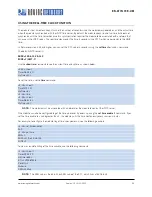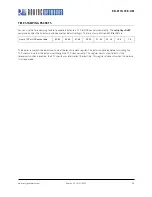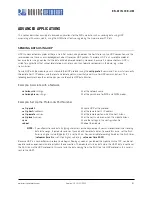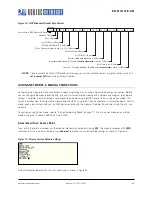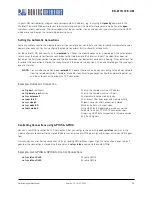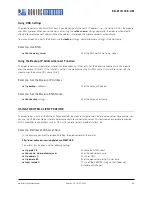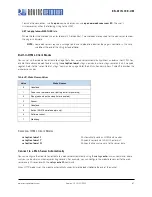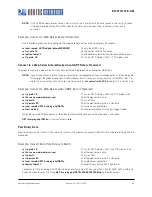
www.rovingnetworks.com
Version 1.0r 9/21/2012
53
RN -W IFLYCR -U M
Table 22. GPIO Pin Usage, Default State & Functionality
Bit
Signal
Name
RN-131
Default State
RN-171
Default State
Default Function
0
GPIO0
N/A
N/A
-
1
GPIO1
N/A
Input
Unused.
2
GPIO2
N/A
Input
Unused.
3
GPIO3
N/A
Input
Unused.
4
GPIO4
Output
Output
Green LED.
5
GPIO5
Output
Output
Yellow LED.
6
GPIO6
Output
Output
Red LED.
7
GPIO7
Output
Output
Blue LED.
8
GPIO8
Input
Output
Unused.
9
GPIO9
Input
Input
Ad hoc mode and factory reset.
10
GPIO10
Output
Output
UART TX.
11
GPIO11
Input
Input
UART RX.
12
GPIO12
Input
Input
Throttles the transmitter if hardware flow control is enabled.
Driving this pin low enables transmitter; driving this pin high disables it.
13
GPIO13
Output
Output
This pin goes high on power up and goes low when the system is
ready. If hardware flow control is enabled, this pin toggles to high to
indicate the RX buffer is full.
14
GPIO14
N/A
Input
-
NOTE:
On the Wi-Fi serial adapter (RN-370) and the RN-174 evaluation board, the blue LED is connected to GPIO7.
The blue LED is NOT connected to GPIO7 on the RN-134 board. It is not possible to power off the blue LED
on the RN-134 board because it is connected directly to power.
Setting the Alternate GPIO Functions
The GPIO4, 5, and 6 default function is to control the LEDs. You can override the default to allow user programmable I/O or
alternate I/O functionality by using the
set sys iofunc
<
mask
> command, where <
mask
> is entered as a hex number. The
hex value represents a bitmask that controls each bit in the <
mask
> and represents a particular GPIO pin. If a bit is 0, then
the corresponding GPIO pin is driven/read by the firmware per the default function. The I/O function <
mask
> is encoded
as shown in Table 23.





















